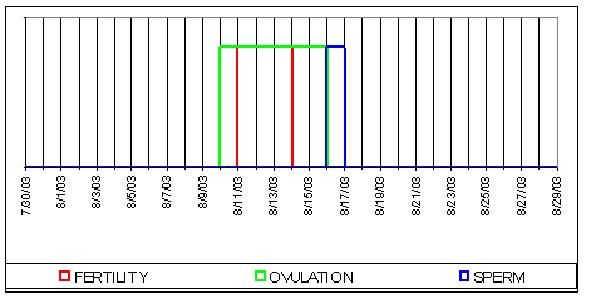
THE BEST TIME TO CONCEIVE
Conception is the fusion of sperm and egg. It takes the sperm a few
hours to travel up the reproductive tract. Therefore, if intercourse
occurs a few hours before ovulation, the sperm will arrive exactly
when the fresh eggs are available. Sperm can survive for up to
3-4 days and egg cells up to 2 days. However, a
egg ages chances for cell defects increase, and
therefore chances of having a healthy baby decrease.
Consequently, the best time for conception is
from 4 days before to 1.5 days after ovulation. Clearly it is very
important to define the ovulation time as accurately as possible.
There are many ovulation test kits on the market today and your
doctor will advise you which is the best for you. One of the most
precise ways is ultrasonography.
There are two main types of ovulation. The most
well known is “ordinary” or “hormonal” ovulation. The “spontaneous”
or “Moon” ovulation is much less well known, but much more
important. The name “Moon” arises from the fact that the
moon has been proven to be most often responsible for
spontaneous ovulation. Ordinary ovulations are well known and nearly
all gynecologists deal only with this particular kind of ovulation.
They calculate its time by subtracting 12-16 days (usually 14 days)
from the beginning of the next menstruation. Six days before this
day is generally considered to be a possible time for
conception. Ordinary
ovulation is linked to the menstrual cycle, so its time can only be
approximated.
Spontaneous ovulation is caused by the moon’s
energy effect on hypothalamus-hypophysis-ovaries-uterus system. This
energy exchange involves much more than just the moon’s
gravity. Many other
forms of energy are involved as well. The moon ovulation differs
from ordinary ovulation in that it has high cycle stability and the
ability to occur very quickly. The latter circumstance leads to the
name “spontaneous.” Another important difference is that this type
of ovulation does not necessarily occur at every lunar phase.
Usually it requires something additional to happen in order to
trigger the ovulation process.
Very often, it can actually be triggered by intercourse.
Statistically, ordinary ovulations are responsible for about 15% of
conceptions, whereas spontaneous ovulations are the source for the
other 85% of conceptions.
Therefore, spontaneous ovulations are more important for
conception, especially since they can be predicted with much better
accuracy than ordinary ovulation.
The spontaneous ovulation is possible at the
moment when the moon will be at the same lunar distance (position of
the moon in orbit) as it was at the moment of the woman’s
birth. This will be calculated
from your date of birth by our scientists. For
predicting a moment of moon ovulation one needs to determine the
lunar distance when the woman was born, and then calculate all
instances when the moon will go through the same point on its orbit.
An accuracy of a few hours is enough for everyday applications, but
for some cases a higher accuracy of about one minute may be
required. Examples of such cases may be insufficiencies in sperm
quality, unexplained infertility or other events.
An example of ovulation prediction for one
month can be found below. Here, a red line shows possible moments
for spontaneous ovulation; a green line shows ordinary ovulation and
a blue line shows maximum sperm activity. This is almost the ideal
case, when both ovulation and the peak of the man’s fertility
coincide. Such moments
have the highest probability of conception.

| 







